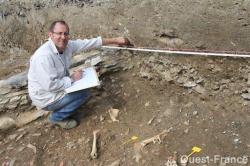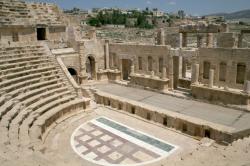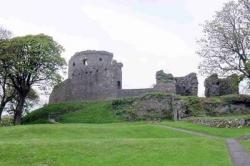INSTITUT SUPERIEUR D'ANTHROPOLOGIE
INSTITUTE OF ANTHROPOLOGY
ONLINE COURSES / COURS A DISTANCE
INSCRIPTION 2012 / Session III : Juillet 2012
REGISTRATION 2012 / Term III : July 2012
FRANCE –  Angers - Depuis début juin, des archéologues de l’Inrap réalisent un diagnostic rue de la Harpe, dans le vieux quartier de la Doutre à Angers. Plus précisément sur le site de l’ancien couvent des Augustins (fin XIIIe - début XIVe siecle). « Nous sommes ici afin d’établir un état des lieux archéologique, dans le cadre d’un futur aménagement du site », indique Martin Pithon, responsable des travaux. Un site qui comprenait, à l’origine, les lieux de culte des frères sacs, ou l’Ordre de la Pénitence de Jésus-Christ. Église, cloître, réfectoire, dortoir, sépultures : le chantier s’étend sur 8 000 m2. « C’est un chantier de taille importante, souligne le spécialiste. On a dû creuser plusieurs tranchées pour évaluer la topographie de l’ancien couvent. » À la clé, des découvertes enrichissantes pour la connaissance de l’archéologie urbaine.
Angers - Depuis début juin, des archéologues de l’Inrap réalisent un diagnostic rue de la Harpe, dans le vieux quartier de la Doutre à Angers. Plus précisément sur le site de l’ancien couvent des Augustins (fin XIIIe - début XIVe siecle). « Nous sommes ici afin d’établir un état des lieux archéologique, dans le cadre d’un futur aménagement du site », indique Martin Pithon, responsable des travaux. Un site qui comprenait, à l’origine, les lieux de culte des frères sacs, ou l’Ordre de la Pénitence de Jésus-Christ. Église, cloître, réfectoire, dortoir, sépultures : le chantier s’étend sur 8 000 m2. « C’est un chantier de taille importante, souligne le spécialiste. On a dû creuser plusieurs tranchées pour évaluer la topographie de l’ancien couvent. » À la clé, des découvertes enrichissantes pour la connaissance de l’archéologie urbaine.
http://www.ouest-france.fr/actu/actuLocale_-Angers.-Le-quartier-de-la-Doutre-livre-son-passe-couvent-des-Augustins_40774-2088932------49007-aud_actu.Htm
JORDANIE –  Jerash - Regional politics, Jordanian hospitality and a stroke of luck kindled a three-decade-old love affair between a team of French archaeologists and one of the Kingdom's most important archaeological sites. Last week marked the 30th anniversary of an excavation by the team that led to the reconstruction of the ancient city of Jerash and the shattering of many assumptions about daily life 2,000 years ago. The team's first excavation uncovered an earlier temple from the Bronze Age, indicating that Jerash was settled some 2,000 years earlier than previously believed. Seigne and his team came back to Jerash in subsequent seasons, with the DoA inviting them to expand their work to other parts of the city, gradually moving from excavation to restoration. Over time, the institute and the DoA went on to rebuild the city stone by stone, reerecting the Temple of Zeus and refurbishing the colonnade and the imposing Hadrian's Arch. With each excavation, the archaeologists also made a series of new cultural and anthropological discoveries that forced scholars to rethink what they thought they knew about Greek and Roman civilisation. These findings include a nearly complete Greek bronze workshop, an inscription bearing the first mention of the Bahraini monarchy, and a hydraulic stone sawmill that represents one of the first machines known to man. The French archaeologists also believe they have found the reason why Roman Emperor Hadrian wintered at Jerash: superstition. Seigne's team and the DoA uncovered a series of inscriptions and artistic depictions indicating that the city was home to several oracles, among them perhaps one of the most renowned soothsayers in the east. "There were much more attractive cities in the empire to vacation at the time," Seigne said. "But it is very likely that Hadrian came to Jerash to consult with oracles for advice." Perhaps one of the team's more groundbreaking discoveries was a seating chart of the city's northern theatre. The inscription demarcating various tribes' seats on the tribal council - a local democratic assembly found throughout the empire - leaves approximately one-fourth of the seats empty. The team believes that the unmarked seats were reserved for a second chamber, making Jerash one of the first and perhaps only cities in antiquity with bicameral legislatures.
Jerash - Regional politics, Jordanian hospitality and a stroke of luck kindled a three-decade-old love affair between a team of French archaeologists and one of the Kingdom's most important archaeological sites. Last week marked the 30th anniversary of an excavation by the team that led to the reconstruction of the ancient city of Jerash and the shattering of many assumptions about daily life 2,000 years ago. The team's first excavation uncovered an earlier temple from the Bronze Age, indicating that Jerash was settled some 2,000 years earlier than previously believed. Seigne and his team came back to Jerash in subsequent seasons, with the DoA inviting them to expand their work to other parts of the city, gradually moving from excavation to restoration. Over time, the institute and the DoA went on to rebuild the city stone by stone, reerecting the Temple of Zeus and refurbishing the colonnade and the imposing Hadrian's Arch. With each excavation, the archaeologists also made a series of new cultural and anthropological discoveries that forced scholars to rethink what they thought they knew about Greek and Roman civilisation. These findings include a nearly complete Greek bronze workshop, an inscription bearing the first mention of the Bahraini monarchy, and a hydraulic stone sawmill that represents one of the first machines known to man. The French archaeologists also believe they have found the reason why Roman Emperor Hadrian wintered at Jerash: superstition. Seigne's team and the DoA uncovered a series of inscriptions and artistic depictions indicating that the city was home to several oracles, among them perhaps one of the most renowned soothsayers in the east. "There were much more attractive cities in the empire to vacation at the time," Seigne said. "But it is very likely that Hadrian came to Jerash to consult with oracles for advice." Perhaps one of the team's more groundbreaking discoveries was a seating chart of the city's northern theatre. The inscription demarcating various tribes' seats on the tribal council - a local democratic assembly found throughout the empire - leaves approximately one-fourth of the seats empty. The team believes that the unmarked seats were reserved for a second chamber, making Jerash one of the first and perhaps only cities in antiquity with bicameral legislatures.
After three decades of unearthing Jerash's history and altering past, the French archaeologists say they now have their sights set on the city's future.
http://www.menafn.com/menafn/1093525087/Jordan-A-chance-romance-Jerash-changes-history-literally
ROYAUME UNI -  Dundrum Castle - The archaeology programme, presented by Tony Robinson, visited the Mournes to find out what existed at the site of Dundrum Castle before the Normans built it. The castle is believed to be about 800 years old but one theory is that John de Courcy, the Norman knight who also built Carrickfergus Castle, had Dundrum Castle built at its south Down site because it was already an important Gaelic dynastic centre. The Northern Ireland Environment Agency (NIEA) and the Centre for Archaeological Fieldwork at Queen's University Belfast also worked on the excavation.
Dundrum Castle - The archaeology programme, presented by Tony Robinson, visited the Mournes to find out what existed at the site of Dundrum Castle before the Normans built it. The castle is believed to be about 800 years old but one theory is that John de Courcy, the Norman knight who also built Carrickfergus Castle, had Dundrum Castle built at its south Down site because it was already an important Gaelic dynastic centre. The Northern Ireland Environment Agency (NIEA) and the Centre for Archaeological Fieldwork at Queen's University Belfast also worked on the excavation.
http://www.4ni.co.uk/northern_ireland_news.asp?id=146088
FRANCE – Boulogne sur Mer - Les archéologues de l'INRAP qui travaillent dans la crypte de la cathédrale de Boulogne ont également entrepris des recherches dans le jardin du presbytère. Après avoir mis au jour un cimetière médiéval, ils sont tombés sur une plaque funéraire recouvrant ce qui ressemble à un sarcophage. Les fouilles vont se poursuivre pour savoir s'il s'agit réellement d'un caveau, ou si c'est une simple citerne recouverte d'une plaque funéraire.
http://www.deltafm.fr/actu/actu-22300.html
IRLANDE – Cork – The first anchor was brought above water just before noon from the seabed where it had lain attached to the wreck of the most famous gun-running ship in Irish history. Yesterday, a team of marine archaeologists and divers recovered the two anchors of the much-storied Aud. The German ship was scuttled in Cork Harbour in 1916 with 20,000 Russian rifles, 10 machine guns and five million rounds of ammunition that were bound for the Irish Volunteers still on board. The second anchor was recovered just before 1pm, off the coast of Cobh in Co Cork. It was the culmination of over two years work by the team that will now begin a three-year conservation of the anchors ahead of the centenary celebrations of the 1916 Rising.
http://www.independent.ie/national-news/almost-100-years-on-anchors-surface-from-gunrun-ship-3144790.html